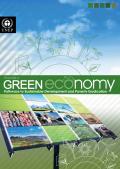This pollution management (PoMa) sourcebook has two major goals. First, it is intended to provide users with current information on available policy tools for pollution management. It is intended as a living document that will be improved over time through periodic review and be updated based on the lessons learned from its application. Second, the sourcebook puts forward the advantages of approaching pollution management through multiple stakeholders (each applying their own policy tools in parallel). Such collaboration can achieve positive outcomes more quickly and ensure a balance between, on the one hand, improved growth and competitiveness objectives, and, on the other hand, pollution management objectives that help to maximize public welfare. In other words, such a collaborative, balanced approach can achieve green and sustainable growth.
The 2012 United Nations Conference on Sustainable Development (UNCSD), or “Rio+20 Summit”, confirmed that if countries, communities and businesses are seriously committed to moving towards a green economy to achieve sustainable development and poverty eradication, then they should consider establishing new measures and metrics that not only reflect these goals, but also inspire action.
Green economy indicators are useful tools for informing policy decisions. They also provide a mirror on the journey to an environmentally stable, economically sound and equitable society. That said, there is no single destination on this journey. There are many pathways depending on a country’s endowments, priorities and policies. This publication intends to foster a better understanding and utilisation of green economy indicators. “Measuring Progress Towards a Green Economy” is a practical guidebook that looks at how indicators can be used in a way that specifically supports and tracks green economy policies.
This new report reveals, for the first time, data on resource use and resource efficiency for all countries of the world over three decades, from 1980 – 2008. The data covers the global, continental and country level, featuring illustrative case studies. The report evaluates the performances of different countries, highlighting the critical issues of current trends in resource use.
The report addresses three main issues:
1. Patterns of material extraction, trade, consumption and resource productivity in different world regions and countries;
2. Connections between material use and indicators of economic and social development;
3. Links between material use and selected major environmental problems, such as carbon emissions, land use change and water use.

The Green Economy Report is compiled by UNEP’s Green Economy Initiative in collaboration with economists and experts worldwide. It demonstrates that the greening of economies is not generally a drag on growth but rather a new engine of growth; that it is a net generator of decent jobs, and that it is also a vital strategy for the elimination of persistent poverty. The report also seeks to motivate policy makers to create the enabling conditions for increased investments in a transition to a green economy.
The report includes chapters on the following areas:
- Agriculture
- Fisheries
- Water
- Forests
- Renewable Energy
- Manufacturing
- Waste
- Buildings
- Transport
- Tourism
- Cities
- Modelling
- Finance
Policies that promote green growth need to be founded on a good understanding of the determinants of green growth and of related trade-offs or synergies. They also need to be supported with appropriate information to monitor progress and gauge results.
Monitoring progress towards green growth requires indicators based on internationally comparable data. These need to be embedded in a conceptual framework and selected according to well specified criteria. Ultimately, they need to be capable of sending clear messages which speak to policy makers and the public at large.
This report responds to these needs and accompanies the OECD Green Growth Strategy. It presents a conceptual framework, a proposal for developing green growth indicators and results for selected indicators derived from OECD databases.
The indicators presented in this report are a starting point: they will be further elaborated as new data become available and concepts evolve. They are accompanied with a measurement agenda that will help addressing the most pressing data development needs.
